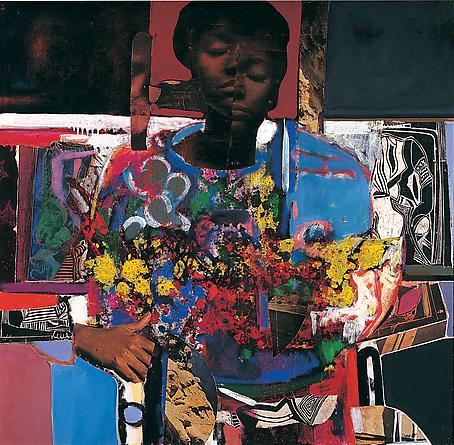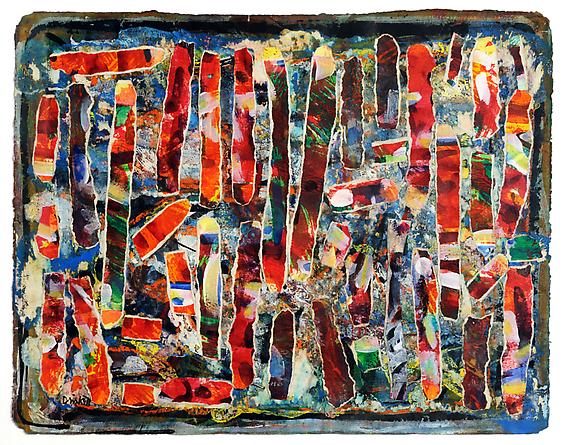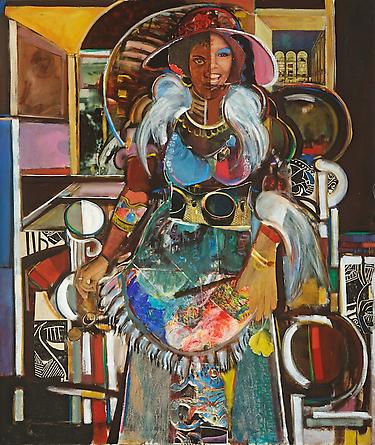
This work – Dancing Angel, 2002 – is part of the collection of the National Gallery of Art, Washington.
About:
Celebrating the art of David Driskell and in honor of his eightieth birthday, DC Moore Gallery’s new exhibition, David Driskell. Creative Spirit: Five Decades, features outstanding examples of his work spanning five decades. In his paintings, drawings, and collages, Driskell unites a strong modernist impulse with personal vision, memory, and aspects of traditional culture. As an artist, scholar, and curator, he has made many contributions to the field that have changed the way we think about American art. Organized by co-curators Julie L. McGee and Adrienne L. Childs for the David C. Driskell Center for the Study of the Visual Arts and Culture of African Americans and the African Diaspora at the University of Maryland, College Park, the exhibition continues at DC Moore through February 4.
Woman with Flowers, 1974.
Driskell’s work bridges modernism, with its figurative and narrative elements, and abstraction. His art pays homage to his childhood in North Carolina, and also reflects the landscape of Maine, where he has had a summer home for many years, and his travels and ties to world culture and the African Diaspora. These diverse sources result in a rich, multifaceted body of work. As co-curator Julie McGee writes in the catalogue, “Driskell’s color, touch, and calligraphic line underpin and unify the multiplicity of the media and stylistic approaches on view” in the exhibition.
Homage to Romare, 1976.
Much of Driskell’s work references African and African American art, often highlighting spiritual and religious dimensions. “I try to pattern my art with certain aspects of African and African-American iconography,” he has said, “in particular with African textiles, with costumes—especially with the Egungun costume, where the Yoruba dancers wear large costumes with strips of quilted cloth.” Masking traditions are important as well, and they recur in his art as both recognizable forms and abstracted images. He also speaks of the lasting impression of his female family members’ “quilt aesthetic.” These multiple strands coalesce in his artwork, particularly in his collages, which are often constructed of multicolored torn strips and mask-like motifs in interlocking patterns.
Ancient Alphabets, 1990.
The universal rhythms of the natural world are another source of inspiration. Many of his landscapes are based on his surroundings in Maine, where he can look out his studio window and see massive pines, slender birches, and other trees of the forest. He is also an avid gardener who feels that working the soil and tending plants is another aspect of his creative process. Here, too, he finds deeper meanings. “The Divine is what I see in nature,” he is quoted as saying in the exhibition catalogue. “They are one and the same, intermingled, entwined, all expressing the joy and beauty of what nourishes us spiritually and otherwise.”
Jazz Singer, 1974.
David Driskell studied at the Skowhegan School of Painting and Sculpture in Maine, and received degrees from Howard University and Catholic University of America. He joined the faculty of the Department of Art at the University of Maryland in 1977 and served as its Chair from 1978-83. In 1976, he curated and wrote the catalogue for the groundbreaking exhibition, Two Centuries of Black American Art, 1750-1950, which established the current field of African American art history. His art is in the permanent collections of a number of major American museums, including the National Gallery of Art, Washington, DC; High Museum of Art, Atlanta; and the Yale University Art Gallery, New Haven. In 2000, he received the prestigious National Humanities Medal. The annual David C. Driskell Prize was established in his honor by the High Museum of Art, Atlanta, in 2005 to recognize major contributions to the field of African American art and art history.
Courtesy: D.C. Moore Gallery New York




